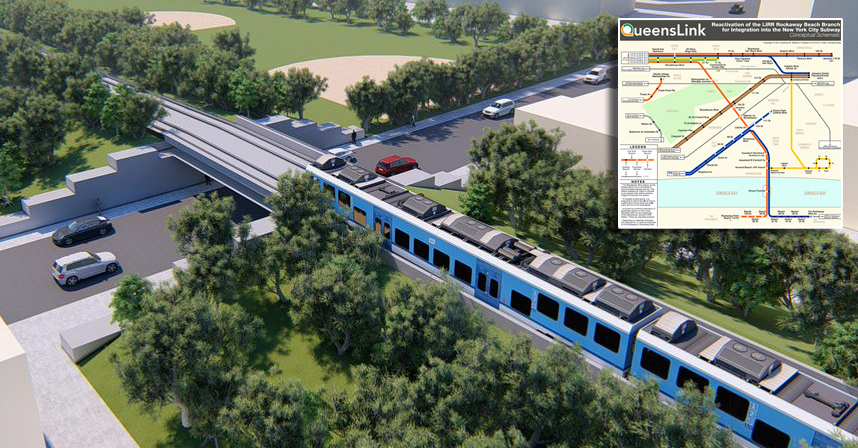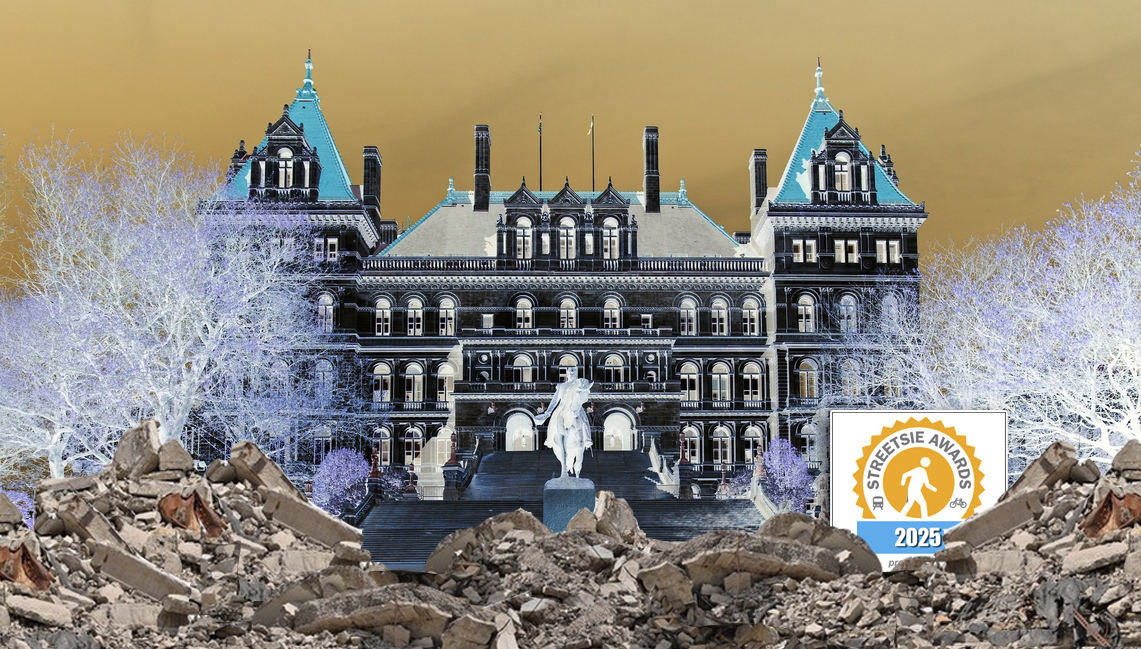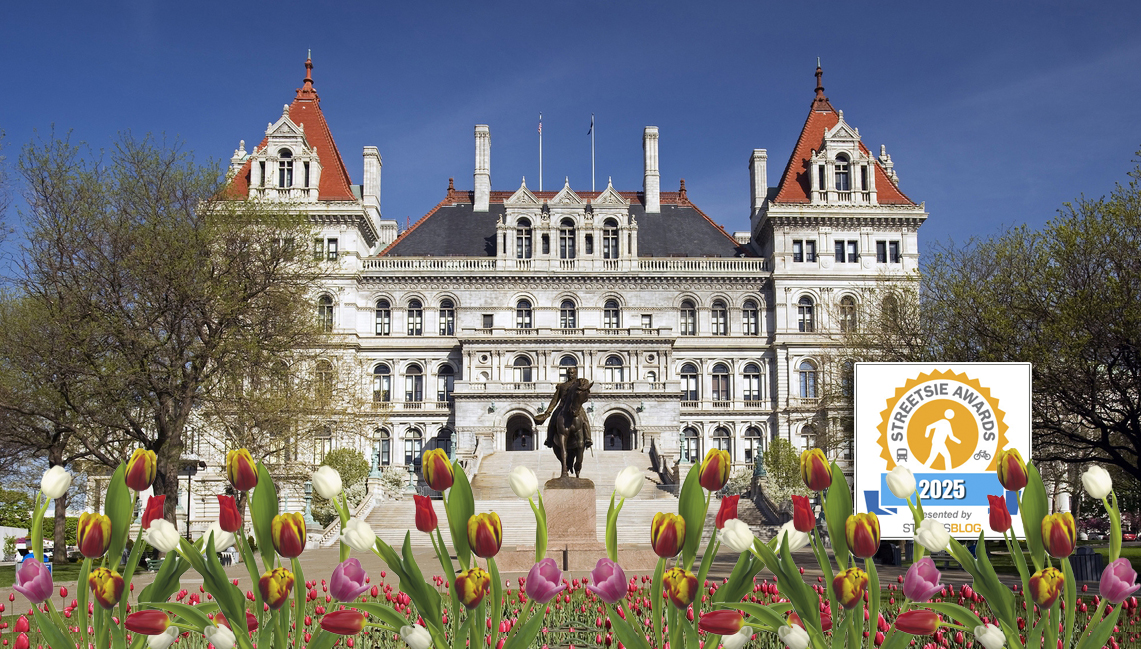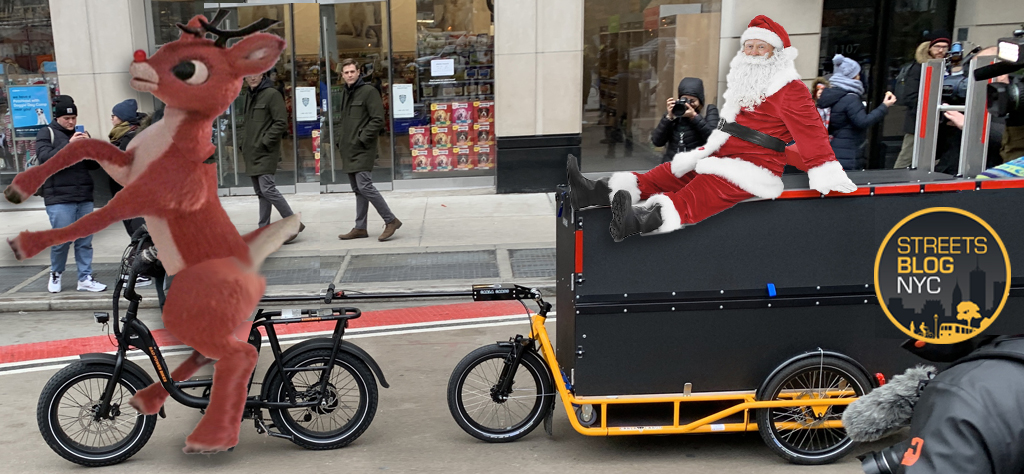Fix this flood at the source.
A recent double fatal crash at the Manhattan Bridge's Canal Street entrance renewed calls for safety upgrades on the chaotic corridor, but also shone a blinding light on the need to repurpose some of the span's "absolutely unnecessary" vehicle lanes – as crossings have dropped by double-digit percentages in the months since congestion pricing began.
At a rally on Wednesday, family and friends of victims of the latest preventable deaths called on the city to finally redesign Canal Street to be less of a car sewer after more than two decades of studies, including one delayed effort from two years ago to add more pedestrian and bike space.
"Mayor Adams and the DOT, shame on you for not fixing this yesterday," said Ron Gentile, a friend of 55-year-old cyclist Kevin Cruickshank who was killed by a driver at Canal Street over the weekend. "This is the fully predictable consequence of the design of this intersection, or park, or highway off ramp, or whatever you want to call it."
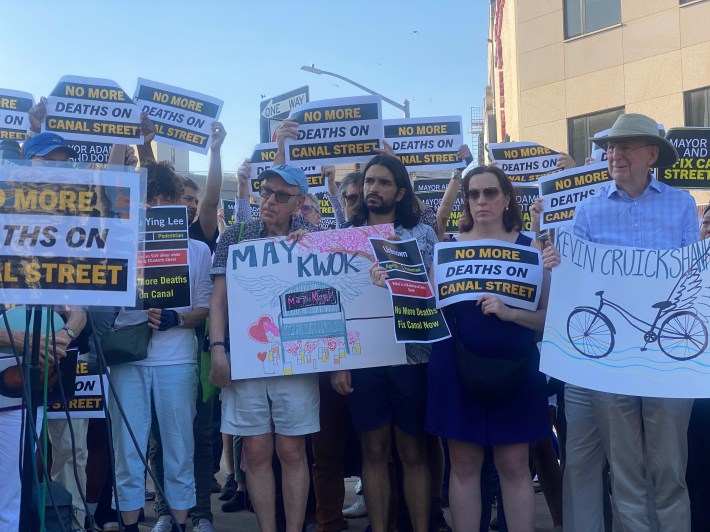
A speeding driver smashed through a pedestrian island on Saturday morning killing Cruickshank and 63-year-old May Kwok, who was sitting on a bench at the time. A second driver crashed into a food truck at the same location within 24 hours, injuring two more people.
"If it was your family member sitting in this park on that bench day after day, would you leave it the way it is, Mayor Adams? Please fix this to honor Kevin, May, and all New Yorkers," Gentile asked.
A group of city, state and federal pols, along with three community board chairpersons, also gave the Department of Transportation 30 days to make public their plans for the strip.
"The lack of timely progress on advancing this project is unacceptable," according to the letter provided by Borough President Mark Levine's office [PDF]. "We urge the DOT not to wait for more crashes and deaths on Canal Street to act."
The city should reduce the speed limit on the bridge from 35 miles per hour to 25, install barriers, parking bans at corners and raised crosswalks along Canal, and give pedestrians a head start for crossing lights, according to the missive, which cited Canal Street's persistent danger.
According to city stats, there have been 692 reported crashes in the last five years along just 14 blocks of Canal between the Manhattan Bridge and the Holland Tunnel entrance. Those crashes injured 45 cyclists, 45 pedestrians and 176 motorists. (A comparable length of 14th Street, for context, had only 259 reported crashes during the same period.)
Cut off the source
Canal Street is in desperate need of a redesign, given its one of the most dangerous roads in the borough, but experts said, why not also address the spigot feeding tens of thousands of cars onto the corridor each day: the Manhattan Bridge.
Crossings on the 1909 span's inbound car lanes dropped by more roughly one fifth after congestion pricing took effect, according to a Streetsblog analysis.
Bridge crossing data comparing before and after the central business district tolling program launched this year is not easily available, but the most recent reliable count was 37,388 average vehicles a day inbound in October, 2023, according to statistics collected by the New York Metropolitan Transportation Council.
A comparable recent month post-congestion pricing logged an average 30,418 crossings each weekday in May, according to the MTA, a decrease of 19 percent.
"Eventually those numbers may creep back up ... so now is the time to grab the additional road space on the Manhattan Bridge that was already unnecessary, but now is absolutely unnecessary," said Annie Weinstock, who leads the firm BRT Planning International and has closely studied the area.
The Manhattan Bridge has for the past decade had five lanes going into its namesake borough, but only two going to Brooklyn, and the city could repurpose the inbound paths for bus lanes or bike lanes, according to traffic planners.
That would allow the bridge's entrance to become a human-friendly space as it was a century ago, when trolleys dropped people off at the plaza to connect to the nearby Third Avenue elevated.
"When the city started introducing motorized traffic on that, they basically ruined the plaza, they destroyed it," said Michael King, the Department of Transportation's former director of traffic calming, who now runs the consulting firm Traffic Calmer. "As we can see, it destroyed people’s lives who were trying to use the remnant of the plaza."
In more recent history, the three lanes on the lower roadway used to flip daily from inbound in the morning rush to outbound in the afternoon, but DOT directed those paths permanently to Manhattan in a 2015 redesign, which was less confusing for drivers, but also added more than double the capacity for one direction over the other.
"Almost any traffic engineer would tell you that that doesn’t make sense," Weinstock said.
For a while, the Manhattan Bridge was the cheap route to drive from Brooklyn to New Jersey, when Staten Island's Verrazzano Bridge was only tolled one way, because motorists would have to only pay the Holland Tunnel charge, Weinstock explained. That changed when motorists had to start paying to cross the Verrazzano either way in 2020, discouraging the Manhattan Bridge cut-through.
And when the Metropolitan Transportation Authority began charging motorists to enter downtown Manhattan this year with congestion pricing, even fewer people chose to cross that span. Unlike other bridges, the Manhattan span doesn't offer a way to bypass the congestion pricing fee. The Brooklyn Bridge, on the other hand, connects to toll-exempt FDR Drive and West Street.
"There’s even less reason to have five lanes going inbound," Weinstock said.
It wouldn't be the first time the lower lanes were shuttered; the city did it for years for construction in the 1990s.
A grand plaza
The bridge's colonnaded archway from the City Beautiful movement hints at a better past, to which the city could return if officials repurposed the three lower lanes, keeping two lanes each way on the upper deck for cars.
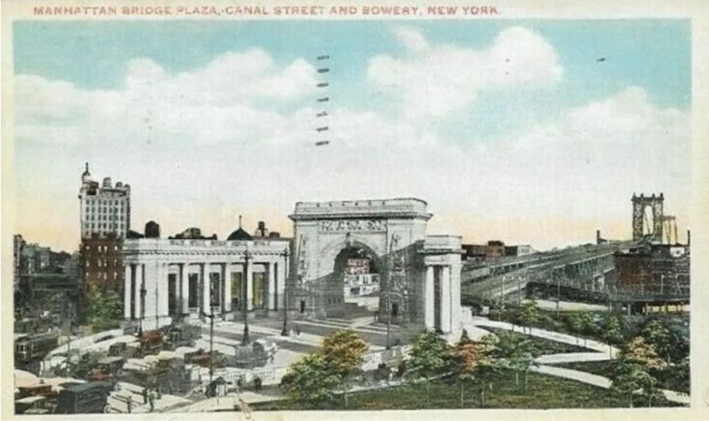
The lanes below could instead become a bike and pedestrian greenway, and set of bus lanes for a new inter-borough bus line, said King, who drew up plans for a possible revamp in 2021.

That would bring the plaza back to its origin of serving as a public transit hub, which would be calmer than regular through traffic, as is the case on the 14th Street busway at Union Square, for example.
"Here’s this big historic space that we should be using to live, not to just funnel [cars]," King said. "Shouldn’t New York City be doing these kinds of things where there’s this big open plaza in the midst of all this congestion."
The extra space would relieve the congested bike and pedestrian paths on the narrow shoulders of the bridge, especially now that faster e-bikes are competing for the same space, said an advocate.
"The Manhattan Bridge is now one of the real constrained crossings for bike and pedestrian traffic because that bike lane is just too narrow," said Jon Orcutt, director of advocacy at Bike New York. "Do [car drivers] even need the lower deck? Should that be a greenway or a busway, or something else that might give us a chance to not have a firehose-style street."
Additional reporting by Nolan Hicks and Yoshi Omi-Jarrett
Editor's note (July 24, 4:27 p.m.): A previous version of this story mistakenly stated that crossings over the Manhattan Bridge dropped by 42 percent after congestion pricing took effect. The actual decline was 19 percent. Streetsblog regrets the error.


